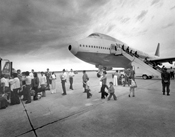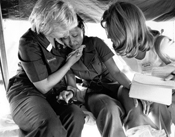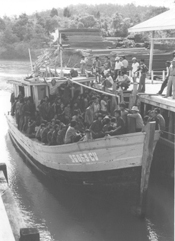April 30, 1975: The Fall of Saigon - Aftermath


Arrival of South Vietnamese refugees. Eglin Air Force Base, Florida. May 1975
(Bryan Grigsby Collection [VA002580])

South Vietnamese refugee comforted by Red Cross volunteers at refugee camp set up at Eglin Air Force Base Florida, May 1975
(Bryan Grigsby Collection [VA002859])

Vietnamese refugees continue to risk their lives on small boats
(Douglas Pike Photograph Collection [VA001710])
RV: What did you feel in April 1975 when you saw those images on television?
GO: Sadness. (becomes emotional) Because it pretty much summed up the futility of the whole experience.
(complete interview; transcript; more information)
May 1, 1975, was a new beginning for Vietnam. For better or worse, those left behind were now under communist rule. Many changes ensued, Saigon became Ho Chi Minh City and the South Vietnamese troops were now part of an army and nation defeated, unsure of their future. At first, the communists concentrated on cleaning up the destruction of war and getting life started again. But soon people began receiving summons to report to "reeducation camps" so they could be properly indoctrinated and become productive members of the new society. The reeducation camps and new government in South Vietnam were so painful that millions of refugees tried to leave the country by any means possible, sparking a decades-long exodus from Vietnam.
For the people who managed to leave Vietnam a new life was in store. They settled in the United States or Europe, and in many cases had to start over after having left Vietnam with nothing. The Vietnamese refugees have managed to not only adapt to their new lives, but to thrive, bringing their culture, traditions, food and language to their new homes.
For the Americans, watching Saigon fall was a rude awakening. Many believed that the last days in Saigon were a final insult in a long and bitterly-contested war. Watching the airlifts, desperate people, and the helicopters being pushed into the ocean to hurriedly make room for more refugees was almost more than some could bear. However, the long involvement with Vietnam was finally over and the country could begin to move forward again.
- Curator: Amy K. Mondt, Reference Archivist
- Layout: Justin Saffell, Webmaster
Vietnam Center & Sam Johnson Vietnam Archive
-
Address
Texas Tech University, Box 41041, Lubbock, TX 79409 -
Phone
(806)742-9010 -
Email
vnca@ttu.edu
